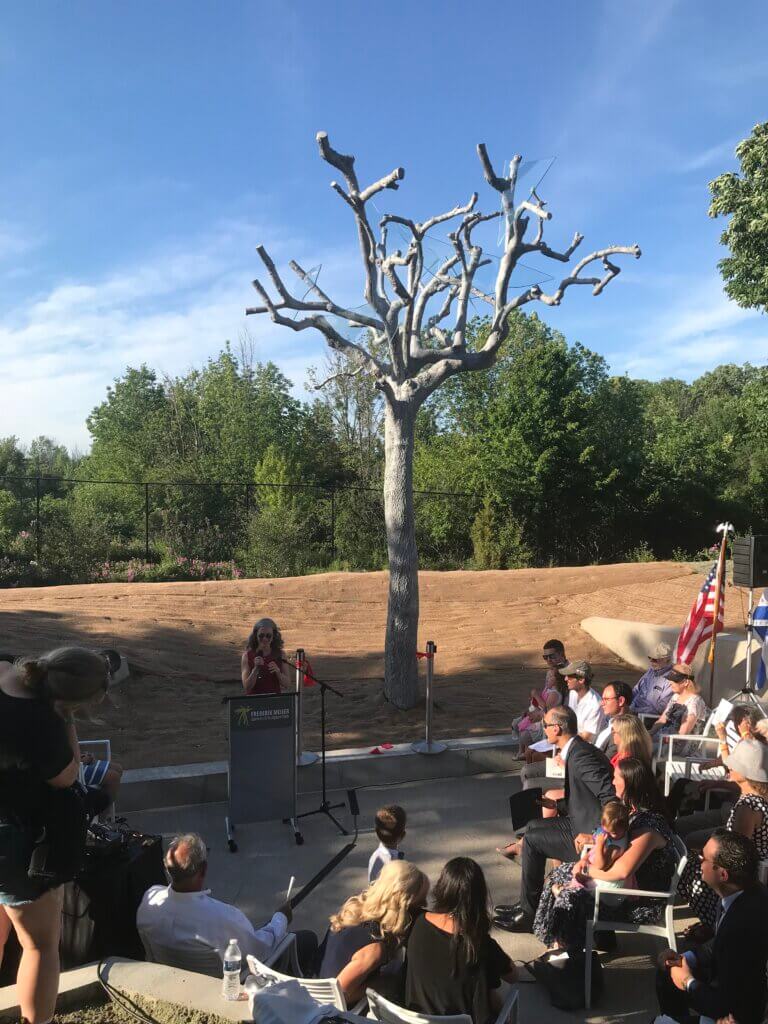Never again. It is the phrase that has been spoken for decades by Jews around the world when discussing the horrors of the Holocaust. Sadly, the scourge of Anti-Semitism and Holocaust denial is still a major threat. Incidents of harassment, vandalism, and assault targeting Jewish people more than doubled in Michigan in 2021, according to the Anti-Defamation League.
On Thursday, June 30, the Frederik Meijer Gardens & Sculpture Park hosted a dedication ceremony for its newest sculpture to commemorate the 6 million Jews who perished in the Holocaust. It was created by artist Ariel Schlesinger and made possible by a donation from Pestka family. The family’s late patriarch, Henry Pestka, survived the Holocaust and moved to Grand Rapids in 1946. Members of the Pestka family were in attendance for the ceremony including Henry’s grandson, Nathan. “We must never forget what humanity is capable of, what happens when we abandon the rule of law, when we scapegoat a group of people that is easy to target, and when humanity simply turns on itself,” Nathan Pestka said.
The monument weighs more than 2 tons and is 20 feet tall. It is an aluminum fig tree with glass shards affixed to its branches. The sculpture, Ways to Say Goodbye, sits between two small hills where visitors can reflect on the statue and its meaning. During his speech, the sculptor reflected on his life as the grandson of Holocaust survivors. “Any artistic act can obscure and distance us from tragedy. There are many ways to remember acknowledge and feel,” Ariel Schlesinger said. “I am an inheritor of trauma. My grandparents survived the holocaust, but not so their parents or extended family. My experience stems from stories, imagination, and pictures.”
Speakers at the dedication included U.S. Sen. Debbie Stabenow, D-Mich., and U.S. Rep. Peter Meijer, R-Grand Rapids Township, grandson of Fred and Lena Meijer. Meijer and Stabenow both talked about how they hope the statue helps educate future generations about the Holocaust.
“The memorial is a testament to why we can’t ignore that type of bigotry and anti-Semitism. It’s a reminder that words today might not just be words tomorrow,” Peter Meijer said. “I know my grandfather would be honored to see what was built.” The artist created an aluminum cast from a living fig tree he found while traveling in Italy. The tree was chosen for its character and as a symbol of the Jewish people. The fig tree is also the first plant mentioned by name in the Bible. The shards of glass in the sculpture’s branches invoke the images of Kristallnacht, German for night of broken glass. It was the symbolic start of the Holocaust when Nazi mobs murdered Jews and destroyed Jewish-owned businesses and homes. “We hope that this sculpture will serve as a beacon of light, a means of inspiration and education for future generations that will view it and carry on its message of hope and remembrance,” Schlesinger said.
